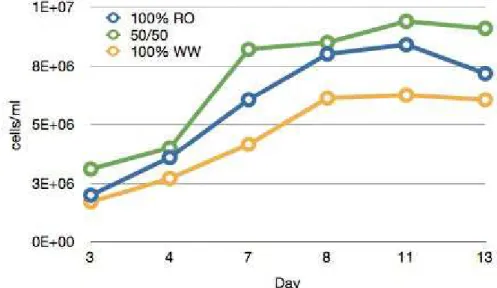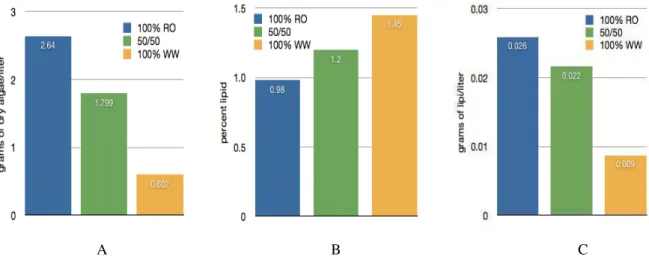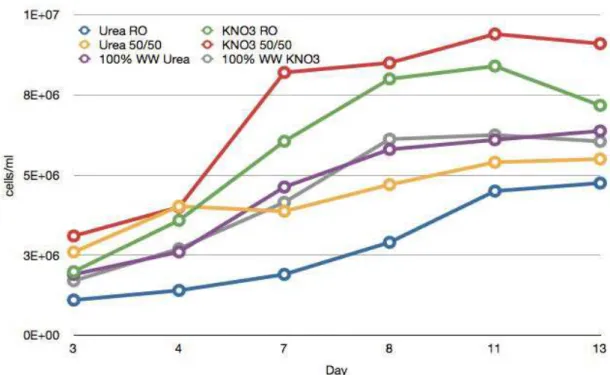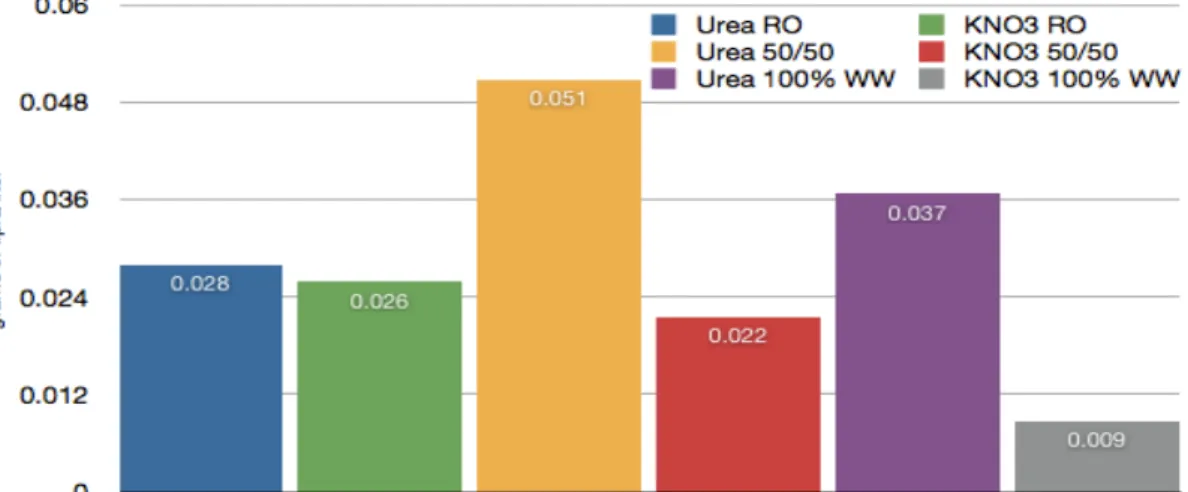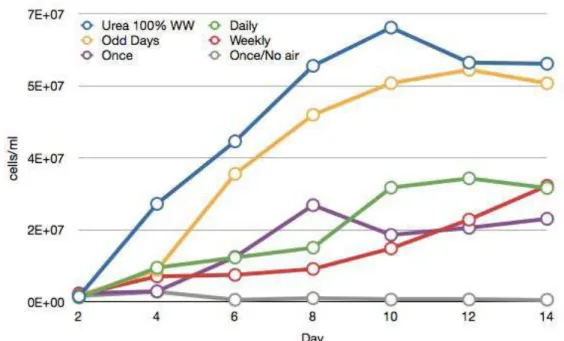SUSTAINABLE PRODUCTION OF
MICROALGAE OIL FEEDSTOCK
USING MUNICIPAL WASTEWATER
AND CO
2
FERTILIZATION
Gina Chaput, Kyle Charmanski, Ihab H. Farag*
Chemical Engineering Department, University of New Hampshire (UNH) W301 Kingsbury Hall, 33 Academic Way, Durham, NH 03824-3591, phone 603-862-2313,
* correspondence: ihab.farag@unh.edu
ABSTRACT: The increasing scarcity of fossil fuels has forced industry to look for new cost effective, clean,
and sustainable sources of energy. With recent advances in technology, biofuels have become a more viable option. Microalgae are cost effective and efficient feedstock for the production of biodiesel. One of the algae advantages is the ability to grow it in a wastewater media. This provides essential nutrients without the addition of chemicals. When grown in a photobioreactor, the algae can be cultivated on non-arable land, preventing competition with food supply unlike other leading biodiesel feedstocks such as canola and soybean crop. The strain of algae used in this study was Chlorella sp. The primary goals of this project were to determine the viability of algae growth in a wastewater medium, test the effectiveness of an alternate nitrogen source, and examine the effects of CO2 fertilization on algae growth and lipid content. Sodium bicarbonate was used to
simulate CO2 fertilization. Results showed that: the use of a 50/50 wastewater/reverse osmosis (RO) medium
yielded 83% of the lipid productivity of a 100% RO medium while the 100% wastewater medium yielded 35% of the lipid productivity; urea as a substitute for KNO3 in 100% RO, 50/50, and 100% Wastewater medium increased lipid productivity by 1.4%, 52.3%, and 88.3%, respectively. The lipid productivity of urea 100% wastewater medium was increased by 68.9% when fertilized with sodium bicarbonate. The optimum trial, a urea 100% wastewater medium with daily additions of sodium bicarbonate, had a lipid productivity of 0.062 grams/liter of growth medium and a volumetric biomass yield of 0.15 grams per liter-day.
Keywords: microalgae; biodiesel; lipid production, biofuels; wastewater
1 INTRODUCTION
1.1 Biodiesel versus Petroleum Diesel: It is quite evident that petroleum based fuels need to be replaced
with a cost efficient and renewable source. A vast number of entrepreneurs are turning to biodiesel as the next generation fuel since it is both renewable and carbon neutral; however, the major feedstock to create biodiesel at a competitive level is oil crop. Oil crop requires significant time, a large area of land, and competes with the food supply; the benefits do not outweigh the inconveniences- slowing down the transition away from petroleum fuels. Due to the insufficiency of crop plants as feedstock for biodiesel production, a new source must be available to supply the lipid/oil for the growing demand of bio-fuels. The source must be space efficient, utilize sunlight for energy, and be capable of multiple uses beyond just biodiesel production. Table 1 shows a comparison of petroleum diesel to biodiesel. Key factors listed are cost per gallon, heating values in Btu per gallon, and CO2 emissions per gallon. Biodiesel produces virtually the same heating value as petroleum diesel
Table 1- Heating Value, CO2 emissions, and price per gallon of Petroleum diesel and Biodiesel [2].
Item Petroleum Diesel Biodiesel
Cost per gallon $3.97 $3.40
Heating Value, Btu/ gallon 130,500 128,000
CO2 emissions, lb/ gallon 26.55 5.84
1.2 Microalgae: Microalgae are photosynthetic, aquatic, single-celled organisms with a high surface-to-volume body ratio. They require CO2, sunlight, nutrients, and water to perform photosynthesis, yet they grow
faster than plants [3, 4]. Microalgae have been shown to produce up to 30 times more oil per acre of land than oilseed crops, with corn and soybean producing 18 and 48 gallons per acre year,respectively [5]. Typical crop plants have a photosynthetic efficiency of 0.2-2.0% [6]. Compared to soybean and canola, microalgae’s simple structure has a far more efficient sunlight absorbance with a typical photosynthetic efficiency of 3-6% [7]. Microalgae may also be grown in non-arable land such as deserts using photobioreactors, and can use multiple water sources like agricultural run-off and municipal wastewater. Thus, algae growth minimizes the use of natural resources and recycles certain inorganic nutrients from waste [8]. Table 2 lists the oil content of select microalgae. Several microalgae produce high amounts of lipids, up to 40% and more in some strains [9], and are therefore viable feedstock for the production of biodiesel [4, 10, 11, 17-20].
Table 2. Oil content of select microalgae [17-20].
Microalgae Oil Content, g/100g
dry algae
Botryococcus braunii 25-72
Chlorella sp. 28-32
Dunaliella primolecta 23
Isochrysis sp. 25-33
Nannochloropsis sp. 31-68
1.3 Wastewater: Wastewater has a high content of nitrogen and phosphorus. Both of these elements are key players in the growth of microalgae [12]. Growing the microalgae in a wastewater medium would not only help the algae grow but remove these otherwise harmful ingredients from the water. Wastewater is also readily available, with 34.4 billion gallons of wastewater being treated daily in the US alone. That is a staggering 12.5 trillion gallons of wastewater per year [13]. The use of wastewater as the primary medium for the growth of microalgae would eliminate competition with the drinking water supply and reduce the cost of the biodiesel production significantly.
1.4 Nutrients : There are a few inorganic nutrients that affect the rate of microalgae growth as well as lipid production. These include phosphorus, nitrogen, and sodium chloride. While wastewater is readily available and varies in nutrient composition, the emphasis in this paper is on maintaining a consistent nitrate level at the start of trials. The microalgae’s metabolic rate is dependent on each of these concentrations. Some examples of nitrate level impacts on the cell include cellular content of thylakoid membrane, activation of acyl hydrolase, stimulation of phospholipids, and diacylglycerol acyltranferase [12]. In a nutrient solution, there are many micronutrients and macronutrients involved; however, there are substitutes for some. Urea is a nitrogen source alternative to potassium nitrate (KNO3) macronutrient. The possibility of using urea could lower the cost of
1.5 CO2 Fertilization: A large environmental concern is the release of CO2 from the combustion of fossil
fuels. In 2007, CO2 emissions in the US totaled over six billion metric tons [14]. As stated earlier, microalgae
are photosynthetic organisms, therefore requiring CO2 to grow and make oil. Khan [15] found that for every 1kg
of algae biomass, 1.8kg of CO2 can be absorbed. An additional advantage of CO2 fertilization is pH control. The
more CO2 is added the lower is the pH of the solution, due to the formation of carbonic acid. Investigations of
the possibility of fertilizing algae with CO2 from certain sources such as flue gases have been increasing.
Bubbling in CO2 gas in a controlled lab environment poses significant challenges in safety, stability, and cost.
For this reason, this project used sodium bicarbonate to simulate the CO2 fertilization; 1.91g of sodium
bicarbonate provides 1g of CO2. In a full scale operation CO2 rich flue gas would be used. This would ideally be
a no cost waste stream from a nearby plant or facility. Using Khan’s 1.8:1 ratio, and an algae yield of 1.33g/L from experiments conducted with 100% RO water done in previous work by the current authors, it was determined that for each 1.5 liter flask of algae 6.86g of sodium bicarbonate should be added [15].
2 GOAL AND OBJECTIVES
Considerable investigations of the growth of microalgae and production of lipids in fresh RO water and in wastewater have been done. Several researchers looked into replacing potassium nitrate with the less expensive urea. Others studied the concept of CO2 fertilization to improve the lipid yield. However, the evaluation of the
combination of the CO2 fertilization, urea substitution and use of wastewater as algae growth medium has not
received much attention. Thus the goal of this paper is to provide data and analysis of the combined use of these three techniques. Therefore the objectives of this research are to: 1- determine the viability of wastewater as the primary medium for the growth of Chlorella sp. 2-determine the viability of urea as an alternative nitrogen source; 3- examine the effects of CO2 fertilization on the growth of Chlorella sp.
3 METHODS
3.1 Algae Growth Medium: To determine the viability of wastewater as the primary medium for the growth of Chlorella sp., the runs were divided into three types; A control 100% RO nutrient medium (with composition given in Ferrentino [4]), a 50/50 mix (50% municipal wastewater and 50% RO water with nutrients), and 100% wastewater nutrient medium.
3.2 Urea: To determine the viability of urea as an alternative nitrogen source the nutrient medium must be tested in the control, 100% RO nutrient medium as well as both the 50/50 nutrient medium and the 100% wastewater nutrient medium. The urea trials were divided up into six separate solutions,
- the control 100% RO nutrient medium made with potassium nitrate,
- a 100% RO nutrient medium made with urea at the same mass concentration as potassium nitrate, - a 50/50 nutrient medium made with potassium nitrate,
- a 50/50 nutrient medium with urea instead of potassium nitrate, - a 100% Wastewater medium made with potassium nitrate, and
- a 100% wastewater medium made with urea instead of potassium nitrate.
3.3 CO2 Fertilization: To examine the effects of CO2 fertilization on the growth of Chlorella sp. in a
100% wastewater nutrient medium using Khan’s 1.8:1 ratio, both concentration and frequency of exposure to the CO2 must be considered. For this reason, the trials were divided up into four groups; one fertilized daily,
every other day, weekly, and once at the beginning. It is important to note that each type of trial is fertilized by the same amount of CO2 overall, an amount pre-determined by Khan’s 1.8:1 ratio and yields from previous
control runs done in this study. As previously discussed, CO2 fertilization was simulated with sodium
bicarbonate due to safety concerns. All of the nutrient mediums for the CO2 fertilization trials were made with
urea instead of potassium nitrate.
3.4 Wastewater Medium: The wastewater used for the nutrient medium was collected from the Dover, NH Wastewater Treatment Facility. The water is UV treated and tested for some key indicators such as pH, nitrate levels, phosphate levels, and BOD (Biological oxygen demand). The wastewater collected from the Dover wastewater treatment plant had a BOD of 30 mg/L, a pH of 6.5-8.5, a nitrate level of 0.7 mg/L, and a phosphate level of 0.4 mg/L.
nutrient medium. This corresponds to an initial algae concentration of 0.0076g/L. Throughout the 14 day growth period, cells counts and absorbance readings were performed every other day. It is important to note that all trials grew for 14 days but not all trials had cell counts performed on the 14th day of growth. Cell counts were done using a hemocytometer to determine the cells per milliliter. Absorbance readings were taken using a spectrophotometer. Key metrics for analysis of the trials include biomass yield (measured in grams of dry algae per liter), lipid content (measured in grams of lipid per 100 grams of dry algae), and lipid productivity (measured in grams of lipid per liter algae medium) [21].
3.6 Algae Harvesting and Collecting: At the end of the 14 day growth period the algae are centrifuged at 5000 RPM for 12 minutes to separate the algae from the medium. The remaining concentrated algae solution is then lyophilized using a solution of acetone and dry ice [21]. To remove any remaining moisture, the lyophilized samples are placed on a freeze dryer. The dried algae mass is then massed to determine the biomass yield of the trial, a key indicator of the growth of the algae. After massing, the dried algae mass is then prepped for lipid extraction.
3.7 Lipid/Oil Extraction: Extraction of microalgae lipid extraction is an important step in biodiesel production. The method adopted is solvent extraction using a modified method of Bligh and Dyer [22]. The dried algae mass is first ground up using a hammer and pestle. The lipid extraction is conducted using a Soxhlet extraction method with a hexane solvent. This process takes approximately 6 hours to remove all the lipids from the biomass. The hexane is then evaporated away and the remaining film of lipids is massed to determine the lipid content (g lipid per 100 g dry algae) and lipid productivity (g lipid per liter of algae medium).
4 RESULTS AND DISCUSSION
4.1 Wastewater vs. RO Water
The RO, 50/50, and 100% wastewater trials showed significant growth over the 14 day growth period, indicating trials progressed through the lag and exponential phase of growth and reached the stationary phase of growth (Figure 1).
Figure 1- The cell counts of the RO, 50/50, and 100% wastewater trials measured in cells/ml.
A B C
Figure 2- The results of the RO, 50/50, and 100% wastewater trials. A is the dry algae biomass yield, measured in grams of dry algae per liter. B is the lipid content measured in percentage of lipids per unit dry algae mass. C is the lipid productivity, measured in grams of lipid per liter.
The lipid contents of the RO, 50/50, and 100% wastewater trials can be seen in Figure 2B. The RO, 50/50, and 100%wastewater trials had a lipid content of .98%, 1.2%, and 1.45%, respectively. The 50/50 trial produced 22% higher lipid content than the RO trial. The 100% wastewater trial produced 47% higher lipid content than both the RO trial and 21% higher than the 50/50 trial.
The lipid productivity of the RO, 50/50, and 100% wastewater trials can be seen in Figure 2C. The RO, 50/50, and 100% wastewater trials had a lipid productivity of 0.0259, 0.0216, and 0.0205 grams of lipid/liter, respectively.
While the lipid productivity of the 50/50 trial was only 83% of the RO trial, successful growth of Chlorella sp.
in a partial wastewater medium was achieved. The slight reduction in the overall lipid productivity of the algae is acceptable considering the significant benefits and advantages of using wastewater as a medium for algae growth. The 100% wastewater also had successful growth and showed that despite having low biomass yield, the lipid content was higher than both 50/50 and RO trials. This indicates a trend of increasing lipid content with increasing percentage of wastewater in the growth medium.
4.2 Urea versus Potassium Nitrate (KNO3)
The urea and KNO3 trials showed substantial growth, over the 14 day growth period, for all trials (Figure 3). All
Figure 3- The cell counts of the urea and KNO3 nutrient solutions in the 100% RO water, 50/50, and 100% wastewater mediums. Cell counts
are measured in cells per milliliter.
The DAB yields of the KNO3 vs. urea trials can be seen in Figure 4. The urea 50/50 solution produced 2.66 g/L,
the highest biomass yield. This is a 47.8% increase over the KNO3 50/50 trial as well as a 0.76% increase over
KNO3 RO trial. The urea 100% wastewater trial produced 1.69 g/L, a 181.7% increase over the KNO3 100%
wastewater trial. Although the biomass yield of the urea 100% wastewater is lower than that of the KNO3 RO
trial, the large improvement of the urea 100% wastewater trial over the KNO3 100% wastewater trial provides a
significant advantage to urea when used in a wastewater medium. A key observation of KNO3 when used in
wastewater is that the biomass yield decreases as the percentage of wastewater increases at a much greater rate than the urea.
Figure 4- The dry algae biomass yield, measured in grams of dry algae per liter, of the urea and KNO3 nutrient solutions in 100% RO water,
50/50, and 100% wastewater mediums.
The lipid content of the urea and KNO3 trials can be seen in Figure 5. The urea RO trial had an 18% increase in
lipid content over the KNO3 RO trial. The urea 50/50 trial had a 58.9% increase in lipid content over the KNO3
50/50. The urea 100% wastewater had a 49.7% increase in lipid content over the KNO3 100% wastewater. As
Figure 5- The lipid content, measured in percentage of lipids per unit dry algae mass, of the urea and KNO3 nutrient solutions in 100% RO
water, 50/50, and 100% wastewater mediums.
The lipid productivity of the urea vs. KNO3 trials can be seen in Figure 6. The urea RO trial had a 1.4% increase
over the lipid productivity of the KNO3 RO trial. The urea 50/50 trial had a 52.3% increase in lipid productivity
over the KNO3 50/50 trial. The urea 100% wastewater trial had an 88.3% increase in lipid productivity over the
KNO3 100% wastewater trial. The same trend present in the lipid contents of the KNO3 and urea trials was
present in the lipid productivities. The urea trials produced more lipids/liter than the KNO3 trials in the 100%
RO, 50/50, and 100% wastewater mediums.
Figure 6- The lipid productivity, measured in grams of lipid per liter, of the urea and KNO3 nutrient solutions in 100% RO water, 50/50, and
100% wastewater mediums.
4.3 CO2 Fertilization
The CO2 fertilization trials showed substantial growth, over the 14 day growth period, for all trials, as can be
Figure 7- Cell counts of the CO2 fertilization trials. Cell counts are measured in cells per milliliter.
The biomass yield results for the CO2 trials can be seen in Figure 8. The CO2 fertilization trials all showed
significant biomass yield except for the trial treated once but with no air. The trial treated daily showed a 24.3% increase in biomass yield over the urea 100% wastewater trial. The treated on the odd days had a 25.4% increase in biomass yield over the urea 100% wastewater trial. The trial treated weekly had a 0.6% decrease in biomass yield over the urea 100% wastewater trial. The trial treated once had a 1.2% increase in biomass yield over the urea 100% wastewater trial.
Figure 8- Biomass yield of the CO2 fertilization trials. DAB is measured in grams of dry algae per liter.
The lipid content results of the CO2 Fertilization trials can be seen in Figure 9. The trial treated daily showed a
Figure 9- Lipid content of the CO2 fertilization trials. Lipid content is measured in percent lipid per unit of mass
The lipid productivity results of the CO2 fertilization trials can be seen in Figure 10. The trial treated daily
produced 0.062 g lipids/L. This is the highest lipid productivity and is 68.9% higher than the urea 100% wastewater trial. The lipid productivity decreased as the frequency of the sodium bicarbonate treatments decreased (from daily to odd days to weekly to once). This decrease in lipid productivity is primarily due to the biomass yields of the trials which showed the biomass yield increased as the frequency of the treatments increased.
Figure 10- Lipid productivity of the CO2 fertilization trials. Lipid productivity is measured in grams of lipid per liter.
4.4 Agreement with published data
Table 3- Comparison Biodiesel Productivity and Land Requirements for Different Feedstocks
Soybean Canola Algae Current Research
Results
Gallons biodiesel (BD)/acre 50 90 ~4,000 2600
Acres/million gallons BD ~24,000 ~14,000 ~250 300
Acres/2.69 billion gallons BD 64,560,000 37,660,000 673,000 800,000
Source: http://www.pioneer.com/usa/agronomy/soybeans/biodiesel.htm, [5]
When comparing volumetric biomass yield to literature, present results show 0.12g /L*day for urea 100% wastewater with no CO2 fertilization and 0.15g/L*day with CO2 fertilization; Chisti’s [17, 18] raceway pond
and photobioreactor yielded 0.1 g/L*day and 1.5 g/L*day, respectively.
Calculations concluded that this research’s photosynthetic efficiency was 4.2%, which is in agreement with the 3-6% in literature values [7].
5 CONCLUSION
Successful growth of Chlorella sp. was achieved in a partial wastewater medium (Figures 2A, 2B, and 2C). Using a medium that was 50% RO water and 50% Wastewater, a lipid productivity that was 83% of the 100% RO trial was attained. With just a slight reduction in lipid productivity, productive algae growth in municipal wastewater was deemed possible. This was noted and further investigation continued using 100% wastewater and found successful growth.
To further optimize the growth of Chlorella sp., urea was investigated as a possible alternative nitrate source in place of potassium nitrate. Using urea as the nitrate source in the nutrient medium, an increase in lipid productivity was observed in the 100% RO, 50/50, and 100% wastewater medium of 1.4%, 52.3%, and 88.3%, respectively. With increases in lipid productivity in all three growing mediums, urea is a viable replacement for potassium nitrate.
Use of sodium bicarbonate to simulate CO2 fertilization resulted in two competing effects. The increased
frequency (one to weekly, every other day, and daily) resulted in an increase in the biomass yield (Figure 8) and decrease lipid content (Figure 9). This indicates the lipid content may be increased by increasing the concentration of sodium bicarbonate. The net effect is an increase in lipid productivity with increased frequency (Figure 10).
ACKNOWLEDGEMENT
The authors would like to acknowledge the support of the US-Egypt Science and Technology funds, USDA Contract 58-3148-8-174. the UNH Hamel Center for Undergraduate Research and the UNH McNair Program, for which authors are grateful. The authors would like to thank Dr. Leland Jahnke for his advice, Dr. Nancy Whitehouse, UNH Dairy Research Center, for help with centrifugation and freeze drying, Jonathan Newell, Nkongolo Mulumba and Thaddeus Webster, UNH Chemical Engineering Dept., for technical assistance.
REFERENCES
[1] USEIA (2011). “Gasoline and Diesel Fuel Update”. Retrieved from: http://www.eia.doe.gov/oog/info/gdu/gasdiesel.asp
[2] USEIA (2011), ORNL Energy Conversion Report (http://bioenergy.ornl.gov/papers/misc/energy_conv.html)
[3] Farag, I.H. (2010) “Carbon Neutral Algae Biodiesel for Food and Energy Security ,“ Invited Presentation, 8th Int. Conf & Exhibition on Chemistry in Industry CHEMINDIX 2010, Oct 18-19, 2010, Manama, Bahrain.
[4] Ferrentino, J (2007),"Microalgal Oil Extraction and In-situ Transesterification," M.S. Thesis, (Advisor I.H. Farag), Chemical Engineering Dept, UNH.
[5] Sheehan, J., Dunahay, T., Benemann, J., Roessler, P.G. 1998. U.S. Department of Energy's Office of Fuels Development, “A Look Back at the U.S. Department of Energy's Aquatic Species Program--Biodiesel from Algae”. Close Out Report, National Renewable Energy Laboratory/TP-580-24190 Retrieved from http://www.nrel.gov/docs/legosti/fy98/24190.pdf
[7] Hall, D.O. and House, J.I (1994), Trees and Biomass Energy: Carbon Storage and/or Fossil Substitution. Biomass and Bioenergy, 6:11-30
[8] Woertz, I.C. (2007) “Lipid Productivity of Algae Grown On Dairy Wastewater as a Possible Feedstock for Biodiesel”. California Polytechnic University. Thesis.
[9] Rodolfi, L., Zittelli, G.C., Bassi, N., Padovani, G., Biondi, N., Bonini, G., Tredici, M.R. (2008) Microalgae for Oil: Strain Selection, Induction of Lipid Synthesis and Outdoor Mass Cultivation in a Low-Cost Photobioreactor. Biotechnology and Engineering, 102: 100-112.
[10] Ferrentino, J, Farag, I. H., Jahnke, L.S. (2006), “Microalgal Oil Extraction and In-situ Transesterification”, AIChE Annual Mtg, Nov 11-13, 2006, San Francisco, CA
[11] Farag, I.H. (2011) “Renewable and Non-Carbon Energy: Technologies, environmental impact, knowledgebase and policies,” Invited Paper, International Conference and Exhibition on Knowledge-Based Business, Industry and Education, KBIE 2011, Bahrain, Jan 8-10, 2011 [12] Xin L., Hong-yin, H., Ke, G., Ying-xue, S. (2010) Effects of different nitrogen and phosphorus concentrations on the growth, nutrient
uptake, and lipid accumulation of a freshwatermicroalga Scenedesmus sp., Bioresource Technology 101: 5494–5500 [13] EPA (U.S. Environmental Protection Agency). 2008. Clean Watersheds Needs Survey 2004.
[14] USEIA (2009). Emissions of Greenhouse Gas Report. Retrieved from: www.ei.doc.gov/1605/ggrpt/carbon.html
[15] Khan, S A, Rashmi, Hussain M. Z., Prasad, S., Banerjee, U.C., (2009) Prospects of Biodiesel Production from Microalgae in India. Renewable & sustainable energy review, 13 (9). pp. 2361-2372
[16] Neal, S. (2009) “Biodiesel and Carbon Policy in the States” Invited Presentation, Kansas Wind & Renewable Energy Conference. [17] Chisti, Yusuf (2007). "Biodiesel from Microalgae." Biotechnology Advances 25: 294-306.
[18] Chisti, Yusuf (2008),”Biodiesel from Microalgae beat Bioethanol,” Trends in Biotechnology 3, 126-131.
[19] Mulumba, N. “Production of Biodiesel from Microalgae,” M.S. Thesis, Chemical Engineering Dept., University of New Hampshire, I H. Farag, advisor, 2010.
[20] Mulumba, N. and Farag, I.H., (2012),” Tubular Photobioreactor for Microalgae Biodiesel Production,” International Journal of Engineering Science and Technology (IJEST), Vol. 4 No.02 February 2012, pp 703-709. (ISSN : 0975-5462).
http://www.ijest.info/docs/IJEST12-04-02-135.pdf
[21] Zuka, Zlatan, McConnell, Brian, Farag, Ihab (2012), "Comparison of Freshwater and Wastewater Medium for Microalgae Growth and Oil Production,” Journal of American Science 2012;8(2):392-398. (ISSN: 1545-1003).
http://www.jofamericanscience.org/journals/am-sci/am0802/055_8150am0802_392_398.pdf
![Table 2. Oil content of select microalgae [17-20].](https://thumb-eu.123doks.com/thumbv2/123dok_br/16432011.196060/2.892.109.429.567.802/table-oil-content-select-microalgae.webp)
